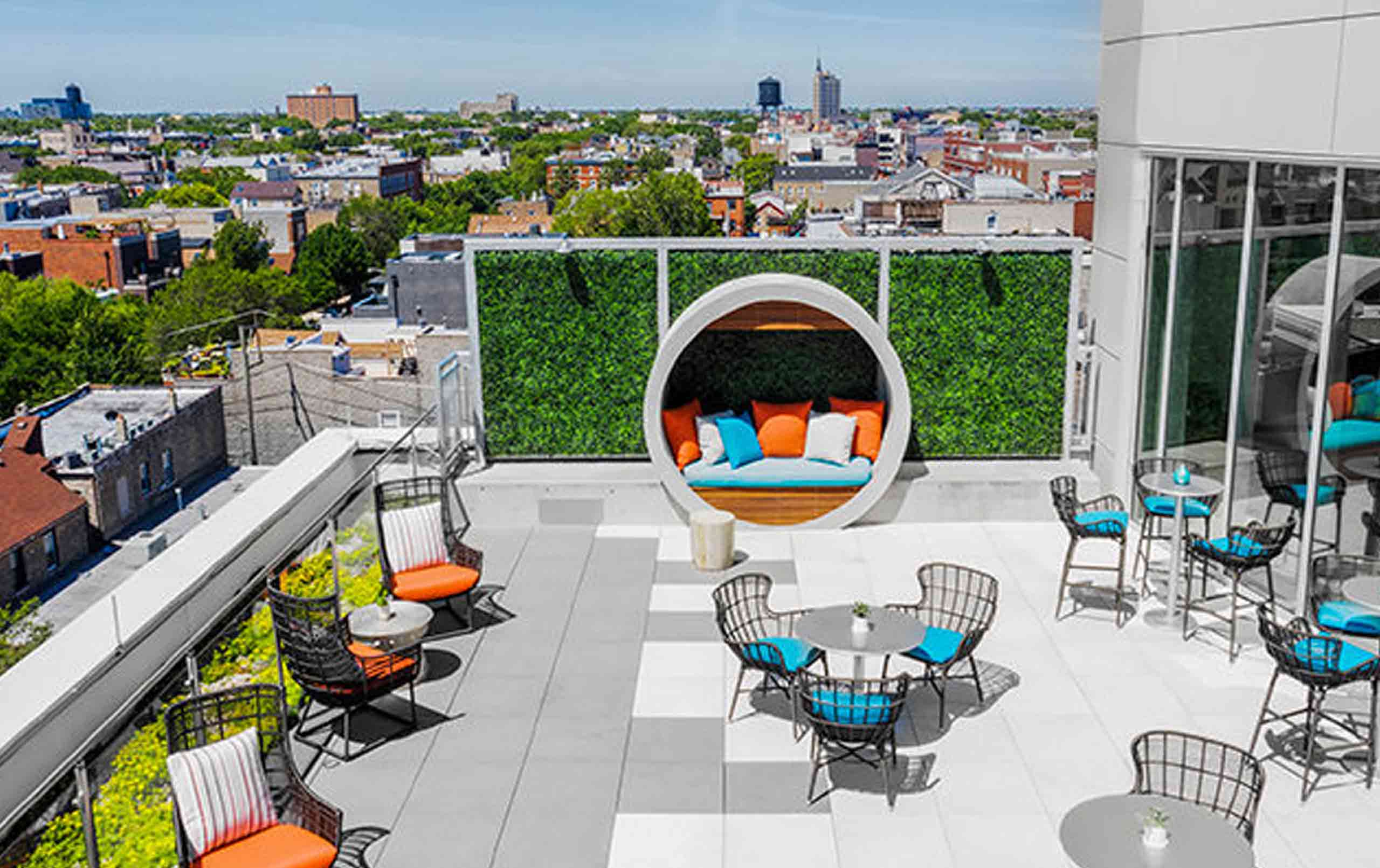
Sky lobby and Kennedy Rooftop bar/restaurant at Hyatt Place Chicago/Wicker Park capture neighborhood charisma, display downtown Chicago for guests and locals
When the elevator opens to the seventh-floor lobby at Hyatt Place Chicago/Wicker Park, guests are in for a treat: 180-degree views of a vibrant lobby, an outdoor restaurant and bar called Kennedy Rooftoop, and beyond that, Chicago’s famed skyline.
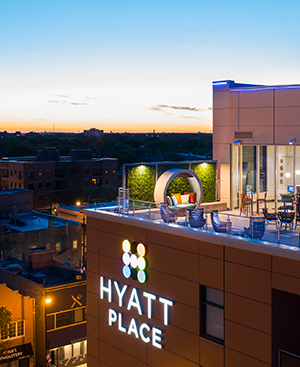
Hyatt Place Chicago/Wicker Park, owned by 1151 LLC and operated by Genuine Hospitality, offers a stylish, yet affordable hotel option located between the Loop and O’Hare International Airport. Clientele ranges from tourists wanting to experience a different part of the city to business travelers trying to avoid the hustle and bustle of the Loop.
The 96,600-square-foot Hyatt Place Chicago/Wicker Park, designed by Legat Architects in collaboration with Sheedy/De La Rosa Interiors, offers parking on its lower level and first two floors, guestrooms on floors three through six and eight, and the lobby and roof deck on floor seven.
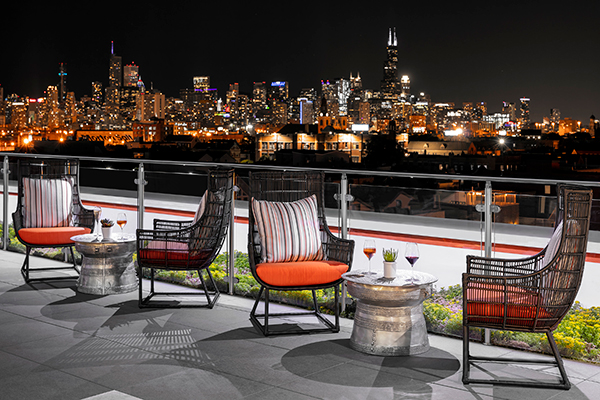
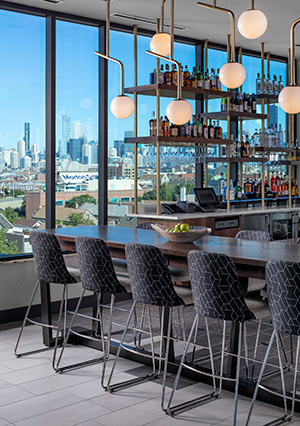
Displaying “Free Artwork” for Guests and Locals
Most buildings in Wicker Park, just under six miles northwest of Chicago’s Loop, are five stories or fewer. This gave Hyatt Place Chicago/Wicker Park, with its seventh-floor lobby, a rare opportunity to showcase its “free artwork”: uninterrupted views of Chicago’s famed skyline.
The wall that faces true south does not offer the ideal skyline view. To overcome the hurdle, Legat oriented the lobby’s floor-to-ceiling glass toward the outdoor terrace and downtown. The resulting views allow guests to see the complete skyline, bookended by Chicago’s two most iconic skyscrapers: 875 N. Michigan Ave. (formerly John Hancock Center) and Willis Tower.
Kennedy Rooftop—the largest outdoor terrace of its kind in Wicker Park—includes an outdoor bar, different seating options, fire pits, and a sport court . . . all energized by the views. Watch the video below to learn more about the sky lobby and Kennedy rooftop.
Legat Director of Hospitality April Maifield said, “The rooftop invites community members to engage with friends and connect with their neighborhood from a different perspective, while enabling guests to interact with Wicker Park locals.”
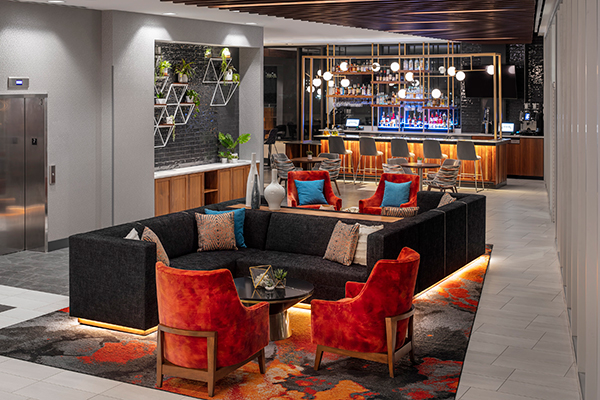
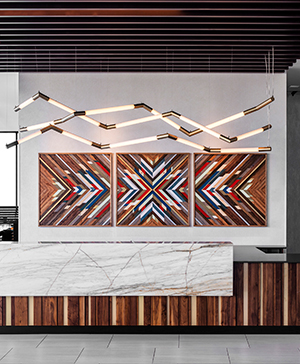
The Wicker Park Vibe
Wicker Park, with its strong architectural character, unique shopping and dining options, and vibrant nightlife, has become a haven for artists and young professionals. A few years back, Forbes ranked the neighborhood number four in its list of “America’s Best Hipster Neighborhoods,” while real estate blog Hotspot Rentals named Wicker Park among the 25 “hottest hoods” in the U.S. According to Walk Score, Wicker Park ranks as Chicago’s “fourth most walkable neighborhood, has excellent public transportation and is a biker’s paradise.”
The design of Hyatt Place Chicago/Wicker Park’s lobby and roof deck drew inspiration from the neighborhood’s fashionable appeal:
- The color palette is grounded with a black base with accents of umber, blue, and gray.
- Custom lighting design is inspired by the neighborhood’s artistic reputation.
- Chicago-based artists used found wood to create the artwork behind the front desk.
- Pops of cream, cyan, and red ocher inspired by the Chicago flag are represented on the outdoor furniture, throw pillows, and planters.
- The dark floor tile extends from the elevator core, transforms to a lighter tone as it reaches beyond the glass wall onto the terrace, and then returns to dark along the guardrail.
Natalie Sheedy of Sheedy/De La Rosa Interiors said, “We looked at how every element in the hotel could be a piece of art, whether it was photography, sculpture, or embroidery.”
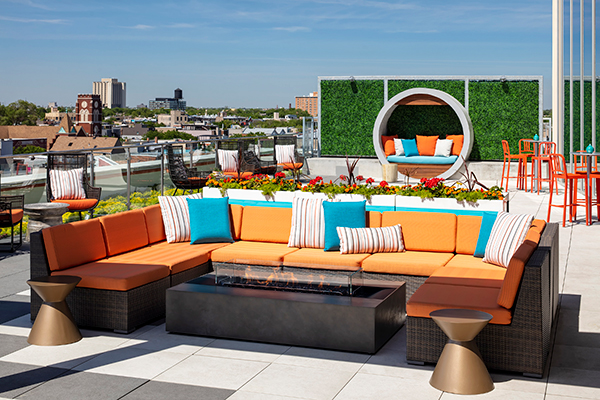
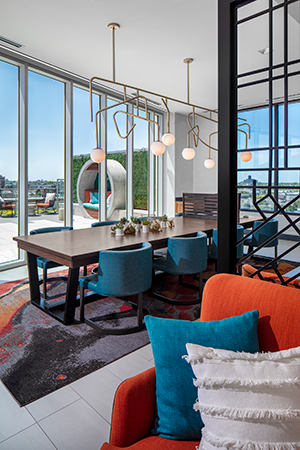
The Interchange
Most guests’ eyes are immediately drawn to an intriguing element on the Kennedy Rooftop: floating within a vegetative wall is a concrete circle that surrounds colorful cushions.
The “Interchange,” named after the expressway’s Circle Interchange, is visible beyond the host desk and creates an anchor point on the west end of the terrace. The concrete form was poured on site to create a color and texture consistent with the exposed structural components on the roof terrace.
The Interchange accommodates groups of three to four people huddling together for a social media photo, or couples relaxing with drinks and a bite to eat. The form’s vantage point, coupled with the simple planning of the roof terrace, capitalizes on the Chicago skyline to create visual drama.
Contact us to learn more about hospitality design, or comment below to share your thoughts on this post.


